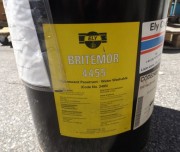
General Appearance
Britemor 4455 is a clear, mobile yellow-green liquid in daylight and appears brilliant yellow under
UVA light of 365 nm peak wavelength (black light).
General Composition
Britemor 4455 is a stable solution of solvents, non-ionic emulsifying agents and fluorescent dyes. It
contains no added sulphur, halogen or inorganic compounds and is essentially ash free on ignition.
Temperature Stability
Britemor 4455 remains stable without precipitation or separation and has good resistance to heat
fade if subjected to prolonged or excessively high temperatures during processing.
Britemor 4455 is typically used for the inspection of precision castings and forgings, machined
surface and fabrications.
Sensitivity Level
Britemor 4455 is approved to AMS 2644, Type 1, Method A & C, Level 2.
Typical Properties
Flash Point : > 100°C (212°F), method: ASTM D 93
Viscosity at 40°C : approx. 8 mm²/s
Density at 20°
C : approx. 0.9 g/cm³
Water Solubility : practically insoluble
Surface Preparation
The successful application of penetrant is completely dependent on the ability of the penetrant to
enter a defect which is open to the surface. All paint, organic coatings, oils, greases, carbon
deposits, rust, scale, flux residues and any other contaminants must be removed completely before
application of the penetrant. When aqueous cleaners are used, it is essential that the component is
thoroughly dried before penetrant application, as water entrapment could reduce the probability of
defect detection.
Application of Penetrant
Methods which can be used include immersion, flow-on, electrostatic, aerosol or conventional
spray, brush-on and wipe-on. In the case of immersion, it is bad practice to drain on to a drip tray
which allows the penetrant to run back into the tank. It is also important to ensure that the penetrant
is allowed to drain from areas of entrapment caused by the geometry of the component. Ideal
processing temperatures for normal use of penetrant lie between 10 - 35°C (50 - 95°F).